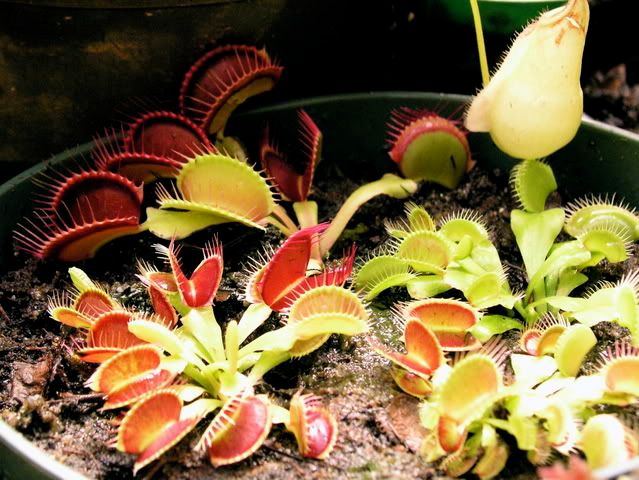|
|
Post by jay on Sept 9, 2007 8:58:57 GMT -5
i know it does not sound very high tech , but i found the best way to colour up traps is to not allow them to feed at all, once they start to trap creatures they lost there colour quickly , thats my 2 cents
|
|
|
|
Post by Flytrap on Sept 9, 2007 10:40:18 GMT -5
Jay ... That's a real interesting observation! I never feed my little chompers... and it sort of makes sense that if the plant was "hungry", it would try it's best to stand out and lure more creatures to it's "mouth". It may also have something to do with the maturity of the plant... at least it's age or establishment of its root system. Again, here is the pic of the same vft 'bigmouth'... the largest cutting is the most red, where as the smallest one is more green. Perhaps when they're smaller, they spend more energy producing food via chlorophyl (sunlight energy?)  And when growing new vfts from seeds, most seedlings are green... but once in a while, you may find in a batch of young germinated seedlings, you'd find the show off seedling in red or purple.  |
|
|
|
Post by jay on Sept 9, 2007 11:17:25 GMT -5
if i want to take a good photo of a plant i seal it off from the any "visitors" and by the end of the week the red pigment really starts to pop up , purpman pointed that out to me in 1999,
i should take some photos of my plants , the group right by the frount door are heavy feeders, but green and down the same shelf near the back with the same light ,ect were the bug really don't make it that far the flytraps have deep pigments ...
|
|
|
|
Post by briar on Sept 9, 2007 13:19:09 GMT -5
all of the above answers are correct.... ;D
plant coloration is a complex subject, plants interact with light with substances such as Flavonoids, Carotenoids, Chlorophylls etc.
These can be used to protect the plant from, or single out a specific wavelength of light, as a defense from or result of a symbiotic relationship with certain microbes, to attract pollinators or in the case of CP's.. even pray. Some photochemical reactions are also used to help protect the plant cells from oxidation, etc etc etc
There can be many complex photochemical processes going on which can result in plant coloration, many of which are still not understood...
so many variables can come into play, sometimes with no apparent rhyme or reason.
But this is also what makes our plants so unique, how boring would it be if everyone's plants looked exactly the same...
Briar
|
|
|
|
Post by eql on Sept 9, 2007 15:53:07 GMT -5
wow.. very technical answer!! sounds impressive! thanks!
|
|
|
|
Post by Sawchuk on Sept 9, 2007 18:03:48 GMT -5
ya your quite the brain briar that makes sense iv always wondered about color although iv never had any probs gettin color in my plants, would you say that the sun is better or a good combination of florescent bulbs?? i know that the sun colors all plants very well once plant has adjusted but i had problems with bulbs even when 4 inch" or closer
im sure that quality of bulb and spectrum also come in to play which can turn in to big $$$
heres a question for ya briar, would you say that nature grows plants better then a artifical setup could?? id say that a human could exceed a plants requirements easily as long as you consentrated it all on one species or kinda plant correct??
|
|
|
|
Post by briar on Sept 9, 2007 18:29:10 GMT -5
LOL, Ive just been around the block a time or two mate.... thats a loaded question Sawchuk... Ive got two B52's from the same TC run, one is outside in my mini-bog and one is inside under my "special" bulb combo, both get the exact same biocontrol cocktail the outside plant is much larger, the inside is much more colorful but smaller, but of course the outside captures much more live food.. so what is the determining factor?... that I cant answer on the question of can you improve upon nature, I have to say yes, absolutely.. but maybe not so much because you have improved any of the positives but maybe because you can eliminate some of the negatives I have never had any of my outside plants approach my inside plants as far as color goes, but I concentrate my light energy in very specific wavelengths there are many animal and plant species that no longer exist in nature but only in captivity, so yes... you can, mainly because nature is a dynamic not a static variable, constantly changing..... for good and for bad, hence the need for evolution. but that may be a load of doo doo too  Briar puts down the bong... hehehe j/k |
|